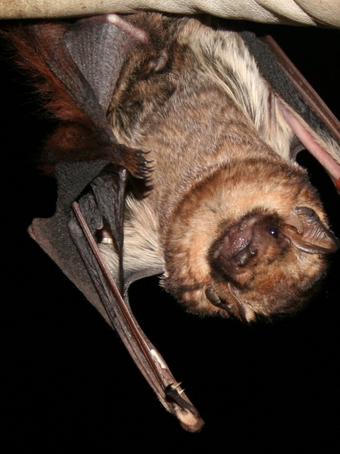
Where on O‘ahu are endangered Hawaiian hoary bats most active? According to an acoustic monitoring study launched in 2017, “by far and way, the bulk of activity is on northern part of the island,” said Joel Thompson of the Oregon-based environmental and statistical consulting firm WEST, Inc..
Thompson presented his results last month at a work- shop at the University of Hawai‘i. His work was one of a number of projects funded by wind farms as mitigation for killing the bats.
His study involved the installation of monitors randomly placed inside 2.3-kilometer square grid cells across the entire island. In the course of field surveys over the past two and a half years, monitors picked up an average of zero to four or five calls a night, with the highest detection rates being in the Wai‘anae and northern Ko‘olau mountains. Detections at Pupukea were particularly high, he said. There and in other primary use areas, as many as 20 calls a night were detected.
The frequency of bat calls varied seasonally, with fewer calls occurring during times when the bats are pregnant or about to be, and more calls after the bats are believed to stop lactating, he said. “Data suggest things are pretty stable,” he said.
“This is really exciting to get this information,” said Jim Jacobi, a member of the state Endangered Species Recovery Committee, which supported Thompson’s research. “We know there are limitations of audio. Do you feel this is an adequate index? Do you think this is representative of activity across the island?” Jacobi asked.
“I feel like it’s doing a pretty good job of showing seasonal patterns.” Thompson replied.
Jacobi asked Thompson whether he had any idea what was driving the consistent bat activity on the north and northwest sides of the island.
Thompson said he didn’t have any good hunches, since some of the high-activity sites were so different from each other.
Committee member Melissa Price cautioned against using Thompson’s data as evidence of bat distribution. Rather, she said, it only showed a distribution of bat calls.
Thompson did concede that a lot of bat activity is not picked up by acoustic monitoring. He cited a study that compared acoustic detections with video recordings. It showed that less than 10 percent of the bats that were there were picked up in acoustic monitoring, he said. He pointed out that microphones only have a range of 20-30 meters and bats can zip through an area pretty quickly. (A later presentation by Ted Weller of the USDA Forest Service showed that the bats sometimes also emitted high-frequency micro-calls that would be nearly undetectable to other animals and some microphones. Or they might fly in complete silence. “There is some evidence they are flying without echolocating,” he said.)
Bat researcher Dave Johnston questioned Thompson’s assumptions about the bats’ reproductive conditions. He argued that individual bats have their own timing. “One will finish before another starts. There is a huge overlap,” Johnston said.
He suggested that Thompson refine his results to describe what percentage of the bats are in a particular reproductive stage at a given time. “Otherwise, I think you’re making a huge assumption.” Johnston said. He also asked Thompson if he evaluated how many calls were made per minute. “It could be one bat circling around an area,” Johnston said.
Thompson said he had not. He added that his firm would be collecting field data for one more year, then move onto more analysis and data mining.
The results are expected to provide a baseline data set to support future research on long-term occupancy trends.
— Teresa Dawson

Leave a Reply